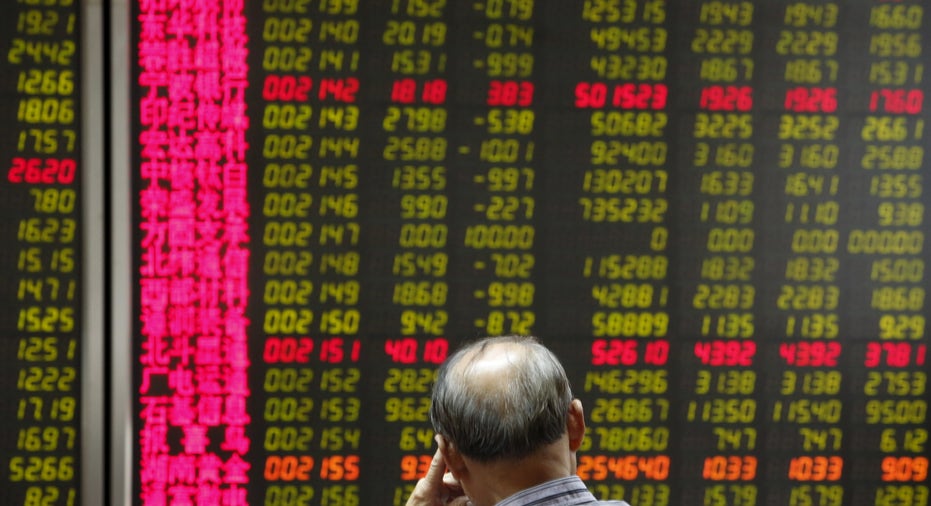China Shares Slip, Oil Slide Outweighs Stimulus Hopes

China's volatile stock markets fell more than 1 percent on Wednesday, though mounting chatter about imminent policy stimulus provided some support against the backdrop of a fresh slide in oil prices, which hit stock markets across the globe.
Asian stocks were down sharply, and Wall Street saw its rally swamped overnight as U.S. crude sank beneath $28 a barrel for the first time since 2003, hammering energy stocks and boosting safe havens.
The benchmark Shanghai Composite Index closed down a fraction over 1 percent after a 3.25 percent bounce on Tuesday, while the CSI300 index of the largest listed companies in Shanghai and Shenzhen lost 1.5 percent, having risen 2.95 percent the previous session.
Tuesday's jump was fueled by expectations that the People's Bank of China (PBOC) would soon act to loosen monetary policy further after the latest data confirmed economic growth hit a 25-year low last year.
The indexes are down 15-16 percent so far in 2016 after a series of sharp sell-offs.
On Tuesday, the statistics bureau also released weaker-than-expected readings on industrial output and retail sales for December, while the Commerce Ministry said on Wednesday that foreign direct investment fell in the final month of the year, and China's external trade faced relatively severe pressure in 2016.
A new survey by the American Chamber of Commerce in China showed that the slowdown is hitting profits at more foreign companies operating on the mainland, and the vast majority believed China's growth would fall well short of the central bank's forecasts of 6.8 percent this year.
Economic concerns have also pressured China's yuan currency, which is down about 5 percent since August, encouraging a destabilizing outflow of capital.
The PBOC has acted aggressively to deter speculators from shorting the yuan. But two surprise devaluation moves from the central bank in six months and a cooling economy have only reinforced market expectations of further yuan weakness.
On Wednesday, the PBOC set a firmer midpoint for the currency at 6.5578 per dollar, from which the spot rate can vary by 2 percent.
The spot yuan was little changed from its previous close, and offshore the currency was just a little weaker, trading about 0.3 percent below the onshore rate.
As authorities clamped down on speculative selling of the yuan offshore, the non-deliverable forwards (NDF) market for the yuan has become an easier and cheaper alternative for punters.
NDF pricing suggests that towards the end of April, the yuan will have declined 1.4 percent.
"Essentially, the market is betting on the yuan fixing flatlining for at least two months and then a big depreciation, just like in August last year," said a trader in Singapore.
The impact of China's sluggish economy and weak yuan has also hit Hong Kong, where many international investors place their bets on China.
The Hang Seng index was down 3.5 percent on Wednesday while the Hong Kong ChinaEnterprises Index tumbled 4.9 percent. The Hong Kong dollar fell to an eight-year low against the greenback.
HOLIDAY CASH
A raft of new regulations have seen yuan trading volumes fall off sharply, pulling the gap between its onshore and offshore levels down from more than 2 percent in the first week of 2016. The gap was fuelling speculation and capital flight and damaging the credibility of China's currency management.
Late on Tuesday, the central bank announced it would inject more than 600 billion yuan ($91 billion) into the banking system to help ease a liquidity squeeze expected before the long Lunar New Year in early February.
Such a move is usual before the holidays and stopped well short of an actual cut in bank reserve requirement ratios (RRR), which would have freed banks to lend more.
China's woes combined with the slump in commodities to prompt the International Monetary Fund to cut its global growth forecasts again on Tuesday. It warned the world's second-largest economy would see growth of only 6.3 percent in 2016.
The government-backed China Securities Journal reported that Beijing had the policy space for further easing to support the economy, including raising deficit spending to around 3 percent of annual economic output.
"The activity data, the domestic market sell-off and unsettled global financial markets require macro policies to stay accommodative for an extended period," wrote David Fernandez, head of Asia Pacific fixed income research at Barclays, in a note to clients.
"We continue to look for two, 25 basis-point benchmark rate cuts in the first half of the year, and maintain our forecast of two RRR cuts."
(Reporting by Pete Sweeney, Samuel Shen and Shanghai and Beijing newsrooms; Writing by Wayne Cole and Will Waterman; Editing by Kim Coghill)